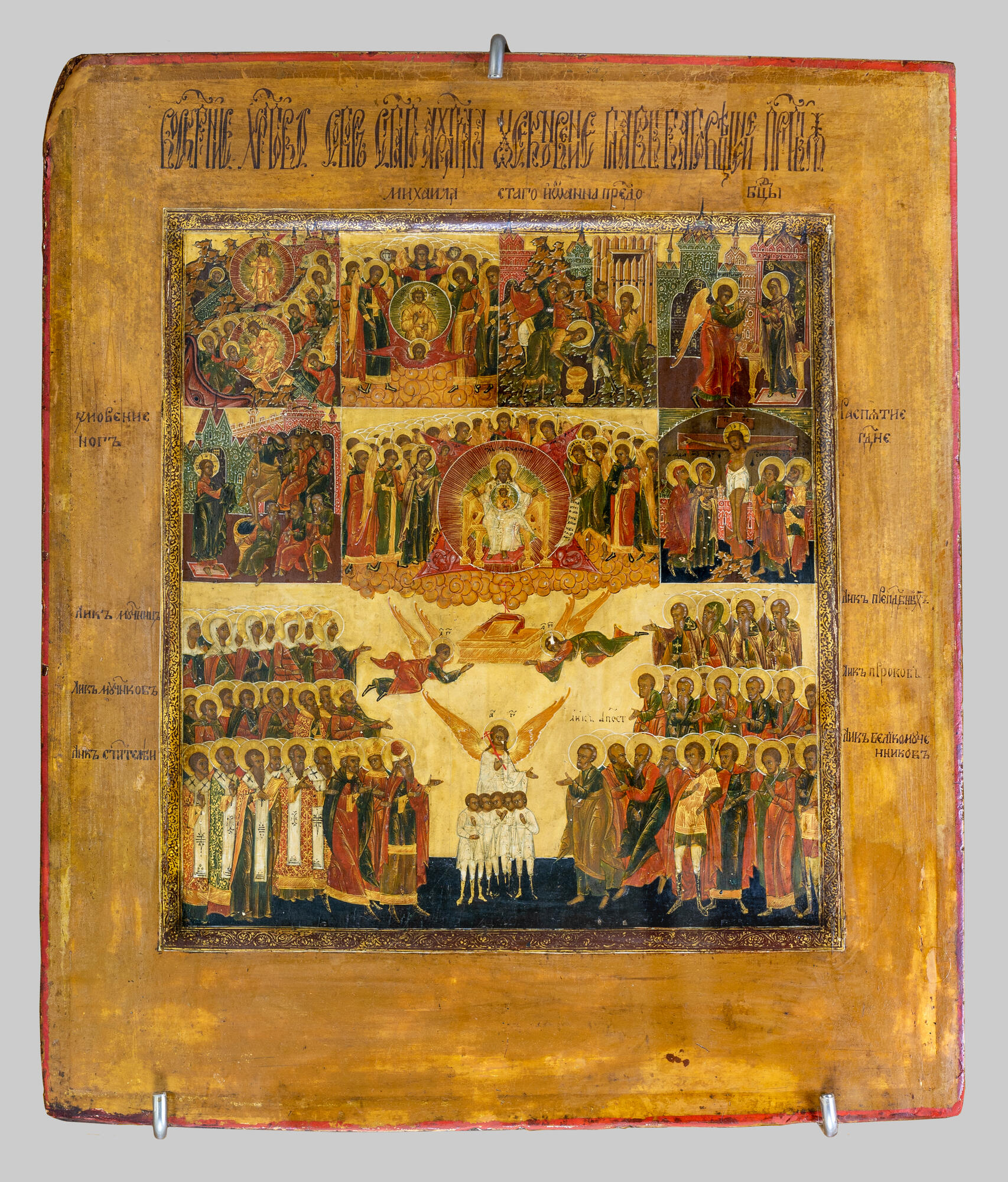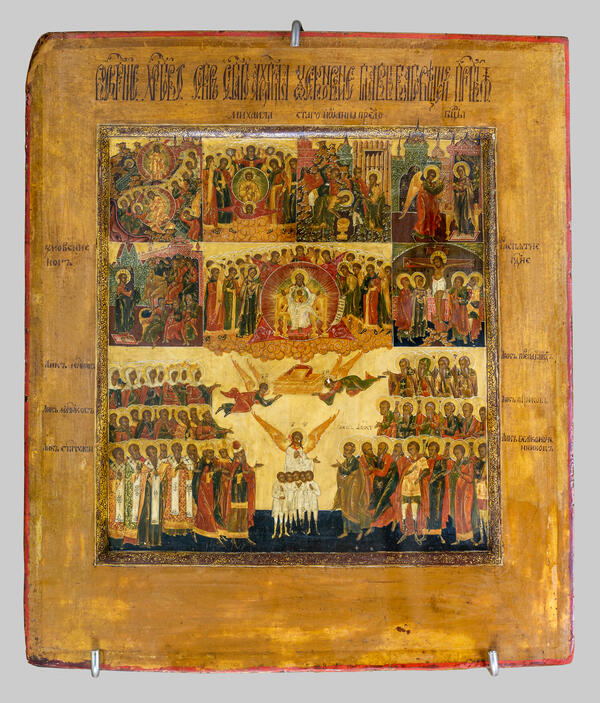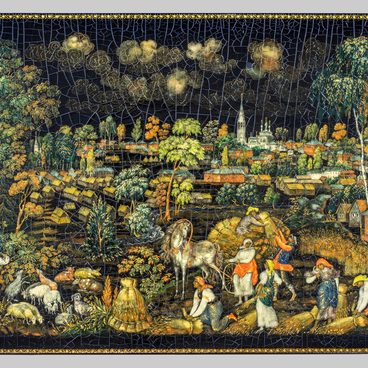The icon Sennight was created by an unknown artist in Palekh in the late 18th century. Such icons are sometimes also called the Hexaemeron.
For a Christian, every day of the week has a sacred meaning. Since ancient times, the six working days have been associated with the six days in which God created the world. And the seventh day, when God ‘rested… from all his work that he had done, ’ was associated with Saturday, the day of rest.
There exist different Hexaemeron texts talking about the days of creation. According to Cyril the Philosopher’s Hexaemeron, the days of the week are connected with important Christian holidays.
Sunday (also called the “Week”) has traditionally been the first day of the week. It is dedicated to the Resurrection of Jesus and the Harrowing of Hell. Monday corresponds to the Council of the Archangels, Tuesday to the Beheading of John the Baptist, Wednesday to the Annunciation, Thursday to the Washing of the Feet, Friday to the Crucifixion, and Saturday to the All Saints' Day. In icons, they are depicted in separate border scenes one after another.
Icons illustrating this order have been known in Russia since the late 15th or early 16th century. Because of the seven scenes associated with seven days, they are often called the Sennight. Alternatively, they can also be called the Hexaemeron, after the text by Cyril the Philosopher or as a reminder of the six days of creation.
In the Palekh Sennight, the Sunday scene is located in the upper left corner. It depicts the most important event of the New Testament, the Resurrection of the Savior. In icons, this composition is often depicted together with the Harrowing of Hell. It is believed that after his death, Jesus descended into hell and rescued all the righteous souls, and with them the progenitors, Adam and Eve. They were saved because he cleansed all people of the original sin by his suffering on the cross.
This image is followed by small border scenes with other plots. The names of the scenes are written on the margins of the icon. Below, in the largest border scene, we can see the All Saint’s Day depicting the righteous celebrating in heaven. On the left, there are three tiers with the faces of martyrs, saints, and kings. On the right we see the images of saints, prophets, martyrs, and apostles.
The Senneth is a typical example of Palekh miniatures of the late 18th century. The artist painted the icon in light golden shades. He applied the paint in thick layers to make the colors more vivid. The illusion of volume is created by the use of dense colors in the shadows and golden highlights. The artist decorated the architectural elements with white ornaments.
The tradition of icons with multiple border scenes formed in Palekh by the end of the 18th century. Small in size, those works were not affected by new trends. The artists used well-established forms of landscapes and architecture and traditional face-painting techniques. Such icons were in great demand, were quite expensive, and were intended for wealthy customers.
For a Christian, every day of the week has a sacred meaning. Since ancient times, the six working days have been associated with the six days in which God created the world. And the seventh day, when God ‘rested… from all his work that he had done, ’ was associated with Saturday, the day of rest.
There exist different Hexaemeron texts talking about the days of creation. According to Cyril the Philosopher’s Hexaemeron, the days of the week are connected with important Christian holidays.
Sunday (also called the “Week”) has traditionally been the first day of the week. It is dedicated to the Resurrection of Jesus and the Harrowing of Hell. Monday corresponds to the Council of the Archangels, Tuesday to the Beheading of John the Baptist, Wednesday to the Annunciation, Thursday to the Washing of the Feet, Friday to the Crucifixion, and Saturday to the All Saints' Day. In icons, they are depicted in separate border scenes one after another.
Icons illustrating this order have been known in Russia since the late 15th or early 16th century. Because of the seven scenes associated with seven days, they are often called the Sennight. Alternatively, they can also be called the Hexaemeron, after the text by Cyril the Philosopher or as a reminder of the six days of creation.
In the Palekh Sennight, the Sunday scene is located in the upper left corner. It depicts the most important event of the New Testament, the Resurrection of the Savior. In icons, this composition is often depicted together with the Harrowing of Hell. It is believed that after his death, Jesus descended into hell and rescued all the righteous souls, and with them the progenitors, Adam and Eve. They were saved because he cleansed all people of the original sin by his suffering on the cross.
This image is followed by small border scenes with other plots. The names of the scenes are written on the margins of the icon. Below, in the largest border scene, we can see the All Saint’s Day depicting the righteous celebrating in heaven. On the left, there are three tiers with the faces of martyrs, saints, and kings. On the right we see the images of saints, prophets, martyrs, and apostles.
The Senneth is a typical example of Palekh miniatures of the late 18th century. The artist painted the icon in light golden shades. He applied the paint in thick layers to make the colors more vivid. The illusion of volume is created by the use of dense colors in the shadows and golden highlights. The artist decorated the architectural elements with white ornaments.
The tradition of icons with multiple border scenes formed in Palekh by the end of the 18th century. Small in size, those works were not affected by new trends. The artists used well-established forms of landscapes and architecture and traditional face-painting techniques. Such icons were in great demand, were quite expensive, and were intended for wealthy customers.



